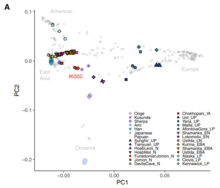Tianyuan man
Tianyuan man (simplified Chinese: 田园洞人; traditional Chinese: 田園洞人; pinyin: Tiányuándòng Rén) are the remains of one of the earliest modern humans to inhabit East Asia. In 2007, researchers found 34 bone fragments belonging to a single individual at the Tianyuan Cave near Beijing, China.[1] Radiocarbon dating shows the bones to be between 42,000 and 39,000 years old, which may be slightly younger than the only other finds of bones of a similar age at the Niah Caves in Sarawak on the South-east Asian island of Borneo.
Isotope analysis suggests that a substantial part of the diet of these individuals came from freshwater fish.[2]
Tianyuan man is considered an early modern homo sapiens. He lacks several mandibular features common among Western or Southern Eurasian late archaic humans, showing its divergence. Based on the rate of dental occlusal attrition, it is estimated he died in his 40s or 50s.[3]
DNA tests published in 2013 revealed that Tianyuan man is related "to many present-day Asians and Native Americans".[4][5][6][7][8] He had also clearly diverged genetically from the ancestors of modern Europeans or Aboriginal Australians.[5] He belonged to mitochondrial DNA haplogroup B.
Tianyuan man exhibits a unique genetic affinity for GoyetQ116-1 from the Goyet Caves in Namur province, Belgium that is not found in any other ancient individual from West Eurasia. He shares more alleles with today's people from the Surui and Karitiana tribes in Brazil than other Native American populations, suggesting a population related to Tianyuan man was once widespread in eastern Asia.[9] His Ydna Haplogroup was K2b.
Two studies from 2021 concluded that distinctive Basal-East Asian (East-Eurasian) ancestry originated in Mainland Southeast Asia at ~50,000 BCE, and expanded through multiple migration waves southwards and northwards respectively. The Tianyuan man belonged to such an East Asian-related population which expanded northwards from Southeast Asia and is Basal to modern East Asians as well as Native Americans.[10][11]

References[]
- ^ "Ancient human unearthed in China". BBC news. April 2, 2007. Retrieved February 26, 2011.
- ^ Hu, Y.; Shang, H.; Tong, H.; Nehlich, O.; Liu, W.; Zhao, C.; Yu, J.; Wang, C.; Trinkaus, E.; Richards, M. (Jul 2009). "Stable isotope dietary analysis of the Tianyuan 1 early modern human". Proceedings of the National Academy of Sciences. 106 (27): 10971–10974. Bibcode:2009PNAS..10610971H. doi:10.1073/pnas.0904826106. ISSN 0027-8424. PMC 2706269. PMID 19581579.
- ^ Shang, Hong (Apr 17, 2007). "An early modern human from Tianyuan Cave, Zhoukoukian, China". Proceedings of the National Academy of Sciences. 104 (16): 6573–8. Bibcode:2007PNAS..104.6573S. doi:10.1073/pnas.0702169104. PMC 1871827. PMID 17416672.
- ^ "A relative from the Tianyuan Cave". Max Planck Society. 2013-01-21.
- ^ a b "A relative from the Tianyuan Cave: Humans living 40,000 years ago likely related to many present-day Asians and Native Americans". Science Daily. 2013-01-21.
- ^ "DNA Analysis Reveals Common Origin of Tianyuan Humans and Native Americans, Asians". Sci-News. 2013-01-24.
- ^ "Ancient human DNA suggests minimal interbreeding". Science News. 2013-01-21.
- ^ "Ancient Bone DNA Shows Ancestry of Modern Asians & Native Americans". Caving News. 2013-01-31.
- ^ Yang, Melinda A.; Gao, Xing; Theunert, Christoph; Tong, Haowen; Aximu-Petri, Ayinuer; Nickel, Birgit; Slatkin, Montgomery; Meyer, Matthias; Pääbo, Svante; Kelso, Janet; Fu, Qiaomei (2017). "40,000-Year-Old Individual from Asia Provides Insight into Early Population Structure in Eurasia". Current Biology. 27 (20): 3202–3208.e9. doi:10.1016/j.cub.2017.09.030. ISSN 0960-9822. PMC 6592271. PMID 29033327.
- ^ Carlhoff, Selina; Duli, Akin; Nägele, Kathrin; Nur, Muhammad; Skov, Laurits; Sumantri, Iwan; Oktaviana, Adhi Agus; Hakim, Budianto; Burhan, Basran; Syahdar, Fardi Ali; McGahan, David P. (August 2021). "Genome of a middle Holocene hunter-gatherer from Wallacea". Nature. 596 (7873): 543–547. doi:10.1038/s41586-021-03823-6. hdl:10072/407535. ISSN 1476-4687. PMID 34433944.
The qpGraph analysis confirmed this branching pattern, with the Leang Panninge individual branching off from the Near Oceanian clade after the Denisovan gene flow, although with the most supported topology indicating around 50% of a basal East Asian component contributing to the Leang Panninge genome (Fig. 3c, Supplementary Figs. 7–11).
- ^ Larena, Maximilian; Sanchez-Quinto, Federico; Sjödin, Per; McKenna, James; Ebeo, Carlo; Reyes, Rebecca; Casel, Ophelia; Huang, Jin-Yuan; Hagada, Kim Pullupul; Guilay, Dennis; Reyes, Jennelyn (2021-03-30). "Multiple migrations to the Philippines during the last 50,000 years". Proceedings of the National Academy of Sciences of the United States of America. 118 (13): e2026132118. doi:10.1073/pnas.2026132118. ISSN 0027-8424. PMC 8020671. PMID 33753512.
External links[]
- Tianyuan, mtDNA B and the formation of Far Eastern peoples
- Yang, M.A.; Gao, X.; Theunert, C.; Tong, H.; Aximu-Petri, A.; Nickel, B.; et al. (2017). "40,000-Year-Old Individual from Asia Provides Insight into Early Population Structure in Eurasia". Current Biology. 27 (20): 3202–3208.e9. doi:10.1016/j.cub.2017.09.030. PMC 6592271. PMID 29033327.
- Fu, Q.; Meyer, M.; Gao, X.; Stenzel, U.; Burbano, H.A.; Kelso, J.; Paabo, S. (2013). "DNA analysis of an early modern human from Tianyuan Cave, China". Proceedings of the National Academy of Sciences. 110 (6): 2223–2227. Bibcode:2013PNAS..110.2223F. doi:10.1073/pnas.1221359110. PMC 3568306. PMID 23341637.
- Upper Paleolithic Homo sapiens fossils
- Peopling of East Asia